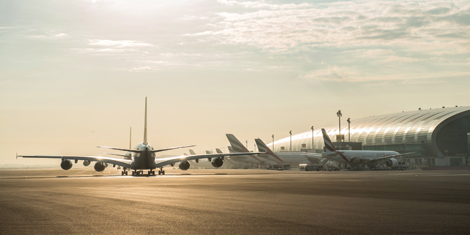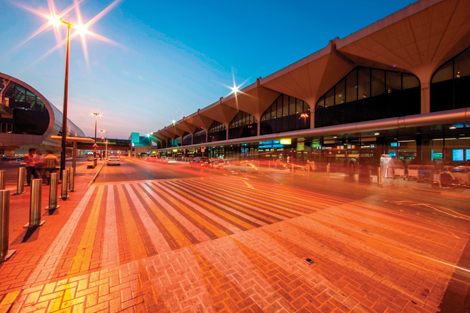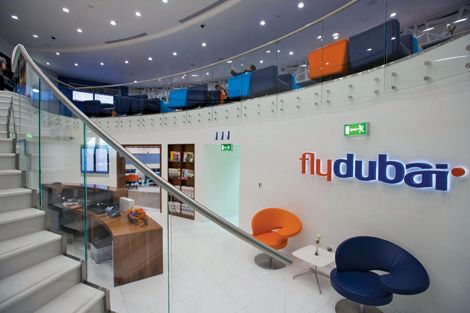Dubai has changed immensely over the past two decades – and a big part of that development has been the ascent of Dubai International airport.
Back in 1993, Dubai was ranked a lowly 44th in the world for international passenger numbers.
Today it’s in pole position. Last year it handled 70.4 million passengers (up 6.1 per cent on 2013) to eclipse London Heathrow. This year it expects to handle 79 million passengers.
This feat was achieved despite the airport being restricted to a single runway for 80 days during the middle of the year as it refurbished and upgraded its facilities.
There is a perception that Dubai raced to the summit spurred by the city’s rapid development, as well as Emirates’ expanding network and bulging order book. In truth it’s the result of five decades of double-digit average annual growth.
Speaking at the recent Future of Borders Conference, Dubai Airports’ CEO Paul Griffiths attributed this success to co-operation and teamwork. The pro-aviation Dubai Government is also clearly a pivotal factor in the airport’s ongoing growth (in contrast to Heathrow and its never-ending expansion debates).

Dubai’s aviation sector contributed $26.7 billion to the Dubai economy in 2013, accounting for some 27 per cent of GDP and supporting 416,500 jobs, or 21 per cent of the emirates' total employment.
Despite reaching number one, there is no sense of complacency. Passenger numbers are forecast to hit 90 million within three years, and reach the airport's 100 million capacity by 2020.
The latest expansion, Concourse D, will be the last of the major concrete developments since Sheikh Rashid Terminal 1 opened in 2000.
Griffiths said the focus now is more on “lateral thinking” and making the best use of IT and processes.
Al Maktoum International Airport, an eye-popping 10 times larger than Dubai International and located at the 140sq km Dubai World Central (DWC), is now operational. A further $32 billion has been earmarked for the next development phase, which is around four times the amount spent on Dubai International’s latest expansion.
But it should be stressed that this ‘phase’ will likely take eight years, and provide capacity for more than 200 million passengers when ultimately completed. It includes two satellite buildings with a capacity of 120 million passengers annually and the ability to accommodate 100 A380 aircraft at any one time (the existing facility at DWC includes a single A380-compatible runway). Last year, DWC handled 845,000 passengers.
Leading A380 hub
Given Emirates is the world’s largest A380 operator (currently 59 in operation), it is no surprise that Dubai International is the world’s leading hub for A380s, by some considerable distance.
The airport handled 15,098 A380 flights to 39 destinations last year, up from the 10,608 scheduled flights to 26 destinations in 2013 (this compares with London Heathrow’s 5,434 A380 flights to 11 cities, and Singapore Changi’s 5,398 A380 flights to 18 destinations).
Saj Ahmad, chief analyst at StrategicAero Research, said: “Emirates has used Dubai as a true global nexus point and leveraged the strength of the A380 as a big people mover and the B777-300ER as a long-haul, high-yield revenue raising machine to augment its growth.”
Concourse A is easily Dubai International’s crowning jewel. Opened in 2013 at a cost of $3.2 billion, it covers 528,000 sqm, spread across 11 floors. It features 20 aircraft contact gates, each capable of accommodating the A380 (two of the gates can handle Boeing 777 aircraft), plus 13 remote stands.
The world’s only dedicated A380 facility, the gleaming concourse boasts a number of firsts, including its underground ‘train’ or Automated People Mover (APM) – the first of its kind in the Middle East – which transports passengers from Terminal 3 to the concourse in just over two minutes. Unlike any other airport facility in the world, its First Class and Business Class lounges have their own dedicated floors with direct access to aircraft boarding gates.
Emirates has six lounges in its flagship Terminal 3 – three for first class and three for business class passengers. Business class seating capacity is highest at Concourse A (2,552) while Concourse B and C have 1,400 and 596 respectively.
The lounges, which extend the entire length of the concourse, are the largest in the world. The food and beverage options are on the world-first list too: UK-based Giraffe’s outlet is the chain’s first international outlet; Jack Daniel’s Jack’s Sports Bar & Grill airport concept was developed specifically for the venue and the world’s first Moet & Chandon ‘Le Lounge’ is located here.
New developments
Concourse D and the refurbished Terminal 1 are on track for completion in the second half of this year.
Concourse D, designated for up to 100 ‘tier one’ international carriers, will increase Dubai International’s capacity to 90 million. The 65,000-square metre concourse, located between Terminal 1 and the Flower Centre, will accommodate up to 18 million passengers per year, and will be connected to Terminal 1 by a Bombardier-built next-generation train.
Touted as DXB’s green building, Concourse D is being built in line with Leadership in Energy and Environment Design (LEED) principles, its most significant feature being the use of solar panels to provide the building’s energy requirements.
Chris Garton, Dubai Airports Executive Vice President of Operations said testing will shortly get underway. “I anticipate we’ll have it ready after the summer holidays, around Q3,” he said.

“Concourse D is designed around a central atrium and has short walking distances. It will be a nice experience as passengers will check in at Terminal 1 and catch the elevated rail link and enjoy views of the airport.”
The concourse is also significant for Emirates, which will be able to park more of its planes in Concourse C as a result of international carriers switching to D.
Terminal 1’s redevelopment is broad encompassing new taxi facilities, security processing and food and beverage venues. “It’s a major facelift and probably will take another 12 months to finish off,” added Garton. Terminal 3 arrivals will also be revamped as the F&B offering “is a bit sparse”, he added.
Garton said while it was a great achievement to become world number one, there was still work to do to be “the best”. “My personal motivation is how best to improve the customer experience and be the best airport in the world,” he said.
flydubai powers Terminal 2
flydubai’s rapid expansion has further underpinned Dubai International’s growth. The ‘hybrid’ carrier – ostensibly low cost, but with an attractive 12-seat business class on its B737-800s – launched an astonishing 23 routes last year, and shows no sign of slowing down. Five-times weekly direct flights between Dubai and Sylhet (its third point in Bangladesh) began on April 1 and will be expanded to a daily service from May 4. Chennai also recently joined its network.
One of the most telling stats is that the airline connected 58 new routes that did not previously have direct air links to Dubai, indicating its importance in generating new passenger and trade flows.
In the space of five years, the carrier has built up a fleet of 44 aircraft and will take delivery of more than 100 by the end of 2023.
The airline now offers its premium passengers access to a comfortable two-floor business class lounge, complete with wifi, food, drinks and magazines. It follows the terminal’s redevelopment, which has seen the introduction of 48 check-in counters and 15 self-service kiosks for flydubai (for all routes except Jeddah and Madina), swelling capacity to 10 million passengers. The dedicated business class counter is the farthest desk, nearest security and immigration.
At peak times there can be queues,Garton said fast-tracking for premium passengers may be an option, although he wants to process all passengers as quickly
as possible.
Lateral thinking
At current growth rates, by 2020 Dubai International will reach its full capacity of 100 million passengers, and air travel traffic through Dubai is forecast to reach 126 million.
The city will host the six-month World Expo the same year, to draw an estimated 25 million visitors.
“One of the concerns that we’ve got is ‘can we actually deliver that level of throughput?’” said Griffiths. “We have to think completely differently, we have to come up with better ways of increasing capacity without actually building buildings. We have to think very laterally.”
That means greater emphasis on IT and ‘smart gates’ to boost passenger handling speeds.

“The focus has to be on protecting the country while welcoming bona fide passengers with maximum courtesy and speed,” added Garton. “The recent move in biometrics is towards iris scanning which is much more reliable technology.”
Technology services company Emaratech recently unveiled ‘eyen’, a smart gate which will scan passengers much faster than existing e-gates. Garton expects passengers will be using the gates in Terminal 3 within the next one to two years. “With the significant numbers of A380s, there are significant waves and the e-gate is the only real solution,” he said.
Dubai Airports is “very close” to removing departure immigration checks so passengers’ essential information can be collated before they travel.
Another project announced at Future Borders concerns the smart trolley, which will be able to go through the X-ray machine along with the baggage, and also have a touchscreen to provide details for passengers about their flights, gates and retail offers. This move is expected to improve efficiency, enabling the machine to handle
400 passengers per hour, up from the current average of between 200-250.
Airport spreads wings
Dubai Airports is no stranger to social media with more than 426,000 Facebook followers and a dedicated app which, from personal experience, I can testify is useful for flight status and gate updates.
But now it has a new force in its armoury, Pedro the Penguin, whose twitter account highlights the airport’s varied lifestyle choices (Twitter address: @DXBPenguin). In the latest video campaign, Pedro swaps frozen Antarctica for the airport's pristine concourses and his adventure is designed to encourage passengers to “go your own way”.
Dubai Airports (dubaiairports.ae) has revamped its website and a ‘live chat’ facility is now available








